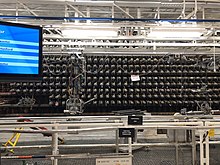B Reactor
First industrial-scale nuclear reactorThe B Reactor at the Hanford Site, near Richland, Washington, was the first large-scale nuclear reactor ever built, at 250 MW. It achieved criticality on September 26, 1944. The project was a key part of the Manhattan Project, the United States nuclear weapons development program during World War II. Its purpose was to convert part of its natural uranium fuel into plutonium-239 by neutron activation, for use in nuclear weapons. Pure plutonium was then chemically separated in the site's T Plant, as an alternative to the Project's uranium enrichment plants. The B reactor was graphite moderated and water-cooled, via a contaminating open cycle with the Columbia River.
Read article
Top Questions
AI generatedMore questions
Nearby Places

Hanford Site
Defunct American nuclear production site

N-Reactor

Arid Lands Ecology Reserve
Shrub-steppe ecosystem in Washington, US
Vernita Bridge
Bridge

Plutonium Finishing Plant
Former industrial facility in Washington state, US
Haven, Washington
Ghost town in Washington (state)

Hanford Engineer Works
Former American nuclear production complex




